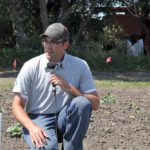
Which weeds will develop resistance?
Stay ahead: know which weeds are most likely to develop resistance to which chemistry

Turning city waste into good fertilizer
Soil Management: Lystek International’s CFIA-registered fertilizer takes waste from sewage to nutrition

Herbicide-resistant weeds: don’t be in denial
Herbicide resistance is a growing problem that all Prairie farmers need to address

Hold off on closing producer-car loading sites, says APAS president
Government needs to "get off the pot" and do a full rail costing review

CN sets new record for grain shipment
Better communication with partners and longer trains help move grain faster, more efficiently
Getting the call: summoned for jury duty
Some people will do anything to get out of the office. Lisa Guenther chose a chance to learn about the courts

Adding heat to dry out grain in the bin

Putting new ag products to the test

Getting back to the roots of our Prairie past
Reporter's Notebook: Lisa Guenther tours what’s left of Cleeves, a once-thriving Saskatchewan town

Diagnosing herbicide injury
Application can go wrong. Know how to limit and recognize herbicide injury


